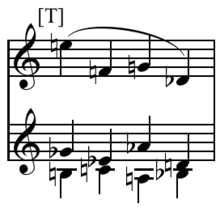Suite for Piano (Schoenberg)

Arnold Schoenberg's Suite for Piano (German: Suite für Klavier), Op. 25, is a 12-tone piece for piano composed between 1921 and 1923. The work is the earliest in which Schoenberg employs a row of "12 tones related only to one another" in every movement:[citation needed] the earlier 5 Stücke, Op. 23 (1920–23) employs a 12-tone row only in the final waltz movement, and the Serenade, Op. 24, uses a single row in its central Sonnet. The basic tone row of the suite consists of the following pitches: E–F–G–D♭–G♭–E♭–A♭–D–B–C–A–B♭.
In form and style, the work echoes many features of the Baroque suite. There are six movements:
- Präludium (1921)
- Gavotte (1923)
- Musette (1923)
- Intermezzo (1921–1923)
- Menuett. Trio (1923)
- Gigue (1923)
A typical performance of the entire suite takes around 16 minutes.
In this work, Schoenberg employs transpositions and inversions of the row for the first time: the sets employed are P-0, I-0, P-6, I-6 and their retrogrades. Arnold Whittall has suggested that "[t]he choice of transpositions at the sixth semitone—the tritone—may seem the consequence of a desire to hint at 'tonic-dominant' relationships, and the occurrence of the tritone G–D♭ in all four sets is a hierarchical feature which Schoenberg exploits in several places".[2]
The suite was first performed by Schoenberg's pupil Eduard Steuermann in Vienna on 25 February 1924. Steuermann made a commercial recording of the work in 1957.[3] The first recording of the Suite for Piano to be released was made by Niels Viggo Bentzon some time before 1950.[3]
The Gavotte movement contains, "a parody of a baroque keyboard suite that involves the cryptogram of Bach's name as an important harmonic and melodic device[4][5] and a related quotation of Schoenberg's Op. 19/vi.[6]
Edward T. Cone (1972) has catalogued what he believes to be a number of mistakes in Reinhold Brinkmann's 1968 revised edition of Schoenberg's piano music, one of which is in measure number five of the Suite's "Gavotte", G♭ instead of G♮.[7] Henry Klumpenhouwer invokes Sigmund Freud's concept of parapraxes (i.e., mental slips) to suggest a psychological context explaining the deviation from the note predicted from the tone row.[8]
References[edit]
Notes
- ^ Whittall 2008, p. 34.
- ^ Whittall 1977, p. 122.
- ^ a b University of Southern California Libraries n.d.
- ^ Stuckenschmidt 1977, p. 108.
- ^ Lewin 1982–83, n.9.
- ^ Klumpenhouwer 1994, p. 246.
- ^ Cone 1972, p. 72.
- ^ Klumpenhouwer 1994, p. 218.
Sources
- Cone, Edward T. (Fall–Winter 1972). "Editorial Responsibility and Schoenberg's Troublesome 'Misprints'". Perspectives of New Music. Tenth Anniversary Issue. 11 (1): 65–75. doi:10.2307/832463. JSTOR 832463.
- Klumpenhouwer, Henry (Autumn 1994). "An Instance of Parapraxis in the Gavotte of Schoenberg's Opus 25". Journal of Music Theory. 38 (2): 217–248. doi:10.2307/843773. JSTOR 843773.
- Lewin, David (1982–83). "Transformational Techniques in Atonal and Other Music". Perspectives of New Music. 21 (1–2): 312–371. doi:10.2307/832879. JSTOR 832879.
- Stuckenschmidt, H. H. (1977). Schoenberg: His Life, World, and Work. Translated by Humphrey Searle. London: Calder.
- University of Southern California Libraries (n.d.) "Arnold Schoenberg Recordings: List of Works: Suite Op. 23 (1923/25)" (Accessed 6 April 2014).
- Whittall, Arnold (1977). Music Since the First World War. London: Dent.
- Whittall, Arnold (2008). The Cambridge Introduction to Serialism. Cambridge Introductions to Music. Cambridge and New York: Cambridge University Press. ISBN 978-0-521-68200-8.


 French
French Deutsch
Deutsch